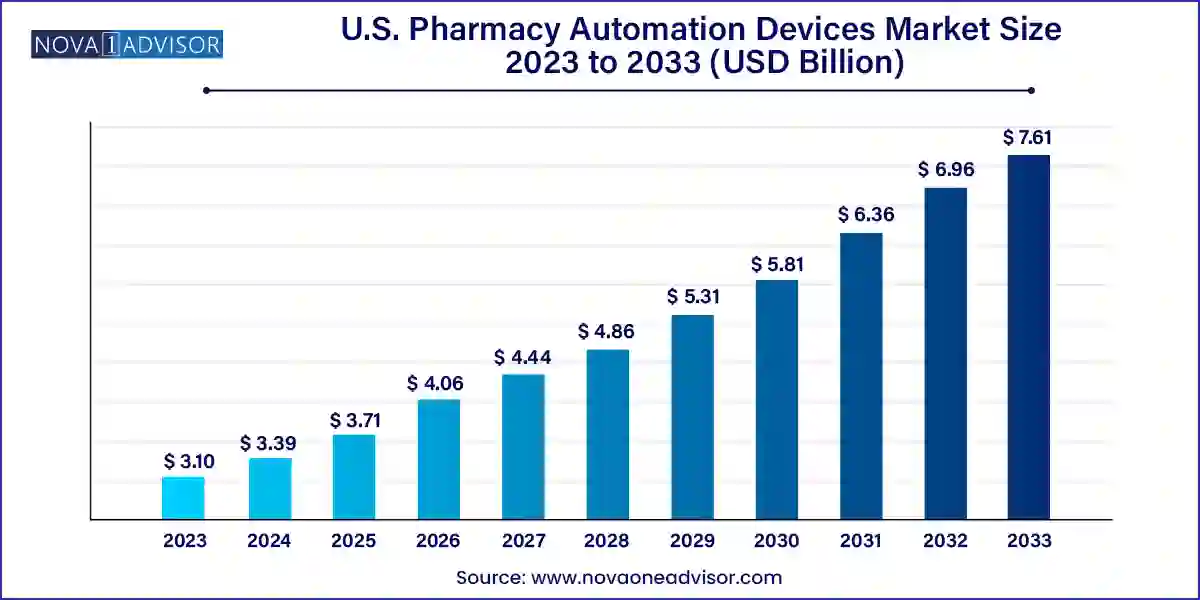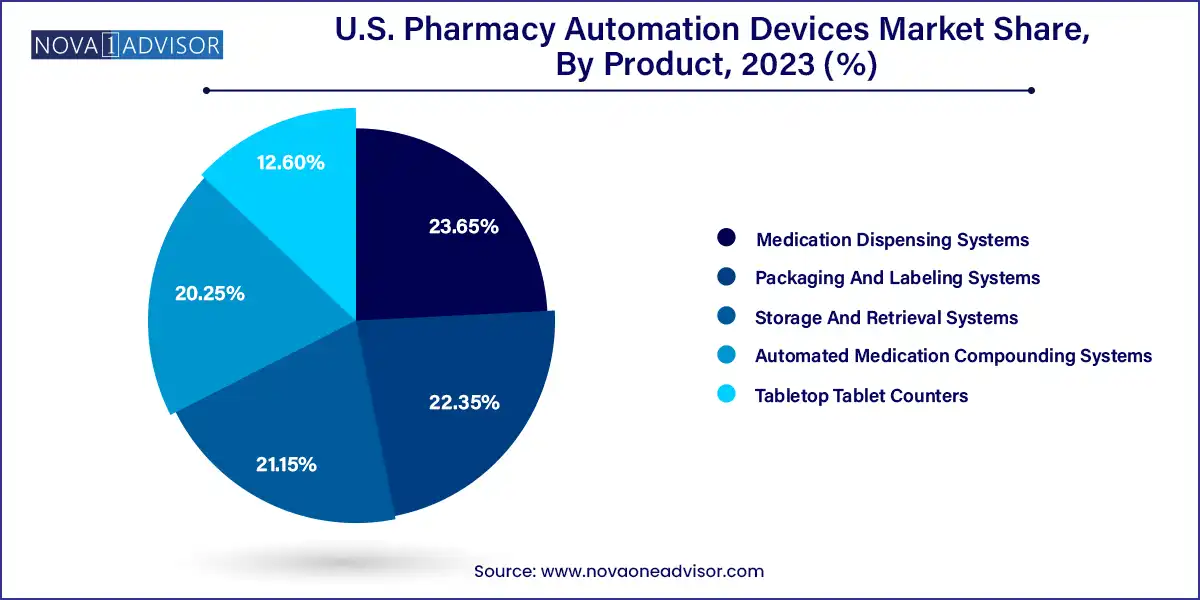U.S. Pharmacy Automation Devices Market Size and Trends
The U.S. pharmacy automation devices market size was exhibited at USD 3.10 billion in 2023 and is projected to hit around USD 7.61 billion by 2033, growing at a CAGR of 9.4% during the forecast period 2024 to 2033.

U.S. Pharmacy Automation Devices Market Key Takeaways:
- Retail pharmacy dominated the market and accounted for the largest market share of 43.15% in 2023.
- Pharmacy benefit management organizations and mail-order is expected to witness a lucrative CAGR of above 10% during the forecast period.
- Medication dispensing systems dominated the market and accounted for the largest revenue share of 23.65% in 2023.
- Automated medication compounding systems is expected to witness the fastest CAGR of 9.7% during the forecast period.
Market Overview
The U.S. pharmacy automation devices market is undergoing a rapid transformation, driven by the increasing need for precision, speed, and operational efficiency in medication management. Pharmacy automation devices encompass a wide range of electromechanical and robotic systems used to manage the storage, dispensing, compounding, packaging, and tracking of medications within various pharmacy settings. These systems are essential in reducing human error, optimizing workflows, minimizing medication waste, and enhancing patient safety.
As the U.S. healthcare landscape becomes more complex marked by rising chronic disease prevalence, polypharmacy, and a shortage of skilled pharmacists the pressure on pharmacies to operate more efficiently without compromising accuracy is intensifying. Automation offers a sustainable solution by alleviating the manual burden associated with repetitive tasks such as pill counting, labeling, and inventory management.
The COVID-19 pandemic further catalyzed the adoption of pharmacy automation by accelerating the demand for contactless operations, remote medication dispensing, and high-throughput systems capable of handling large prescription volumes. In parallel, the growth of mail-order pharmacies and pharmacy benefit management (PBM) organizations has expanded the scope for large-scale automation platforms.
Pharmacy automation is no longer limited to high-end hospital systems; small retail and independent pharmacies across the U.S. are investing in compact, cost-effective solutions such as tabletop tablet counters and automated labeling machines. As healthcare shifts toward patient-centric, data-driven, and outcome-oriented care models, the role of pharmacy automation devices in achieving compliance, improving therapeutic accuracy, and optimizing resource utilization is more vital than ever.
Major Trends in the Market
-
Rise in Robotic Dispensing Systems: Robotics are increasingly used in high-volume pharmacies for precise, multi-tasked medication filling and real-time inventory control.
-
Integration with Electronic Health Records (EHR): Pharmacy systems are being connected with EHR platforms for real-time prescription verification and decision support.
-
Growth in Central Fill Automation: Mail-order and PBM players are investing in centralized automation hubs to fill thousands of prescriptions per hour.
-
Miniaturization of Systems: Compact and modular automation devices are being adopted by small and mid-sized retail pharmacies to improve efficiency with limited space.
-
Artificial Intelligence and Predictive Analytics: AI is enabling better inventory forecasting, demand planning, and personalized medication regimens.
-
Sterile and Hazardous Drug Compounding Robots: USP <800> compliance is driving adoption of fully enclosed robotic compounding systems for oncology and IV medications.
-
Increased Investment in Cloud-Based Platforms: SaaS-enabled platforms allow remote control, diagnostics, and predictive maintenance of automation devices.
-
Workforce Shortages Driving Automation: Labor shortages and burnout among pharmacists are leading healthcare systems to embrace automation for sustainability.
Report Scope of U.S. Pharmacy Automation Devices Market
Market Driver: Rising Prescription Volume and Complexity
One of the strongest drivers for the U.S. pharmacy automation devices market is the increasing volume and complexity of prescriptions, particularly for chronic disease management. With over 66% of American adults taking at least one prescription drug and approximately 27% using five or more, the traditional manual dispensing model is under immense strain. Moreover, as personalized medicine and specialty therapies (e.g., biologics, oncology medications) grow, the need for accuracy and adherence to detailed administration protocols also rises.
Automation devices, particularly robotic dispensing systems and automated medication compounding units, ensure that prescriptions are filled accurately, efficiently, and with minimal delay. These systems reduce medication errors a leading cause of adverse events in U.S. healthcare settings and allow pharmacists to shift their focus to clinical roles such as patient counseling, therapy monitoring, and medication reconciliation. In essence, automation becomes not just a cost-saving tool but a clinical enabler in modern pharmacy practice.
Market Restraint: High Capital and Maintenance Costs
Despite its clear advantages, the high initial cost and ongoing maintenance of pharmacy automation devices act as a restraint, particularly for smaller institutions and independent pharmacies. Full-scale robotic dispensing systems, storage carousels, or IV compounding robots can cost several hundred thousand dollars. Beyond the capital investment, facilities must budget for technician training, software integration, maintenance contracts, and infrastructure upgrades (e.g., climate-controlled cleanrooms for compounding robots).
For many pharmacies operating on narrow margins, especially in rural or underserved areas, these costs may outweigh the short-term benefits. Additionally, rapid technological changes mean devices can become outdated in a few years, making ROI calculations challenging. These financial hurdles may slow adoption in certain segments, even as market leaders continue to scale.
Market Opportunity: Expansion of Mail-Order and PBM Pharmacies
A promising growth opportunity lies in the expansion of mail-order pharmacies and pharmacy benefit management (PBM) organizations, which handle large prescription volumes across regional or national levels. These entities require high-throughput, scalable automation solutions that can process thousands of prescriptions daily with minimal manual intervention. From packaging and labeling systems to robotic sorters and verification scanners, the automation potential in this segment is immense.
As patients increasingly adopt home delivery models for chronic medications spurred by the pandemic and digital health boom mail-order and PBM pharmacies are poised to become central players in the U.S. pharmacy ecosystem. This shift also allows for centralized automation hubs, lowering per-unit operating costs and enhancing error control. Companies like Express Scripts, CVS Caremark, and OptumRx are actively investing in AI-powered fulfillment centers, driving innovation and competition in the automation space.
U.S. Pharmacy Automation Devices Market By End-use Insights
Inpatient pharmacies represent the largest end-use segment in the U.S. pharmacy automation devices market. These hospital-based pharmacies rely heavily on automation to manage large, complex formularies and ensure timely medication delivery across departments. Automated dispensing cabinets, robotic storage systems, and barcode-enabled verification systems help inpatient pharmacies comply with stringent clinical and regulatory standards, including those outlined in USP <800>, The Joint Commission, and CMS Conditions of Participation.
In addition to dispensing efficiency, automation improves medication safety—a critical factor in acute care environments. Integration with computerized physician order entry (CPOE) systems and electronic medication administration records (eMAR) ensures that the five rights of medication use (right patient, drug, dose, route, and time) are adhered to at every step.
Conversely, pharmacy benefit management organizations and mail-order pharmacies are the fastest-growing end-use segment. These institutions handle large-scale medication fulfillment, often using centralized automation hubs to achieve cost savings and accuracy. PBMs are also leveraging predictive analytics to anticipate refill needs and reduce medication waste. The growing emphasis on chronic care management, telepharmacy, and direct-to-home services will further accelerate investment in this space.
U.S. Pharmacy Automation Devices Market By Product Insights
Automated Dispensing Cabinets (ADCs) dominate the U.S. pharmacy automation market due to their widespread use in hospital inpatient settings. These secure, electronically controlled medication storage units allow nurses and pharmacy staff to access medications near the point-of-care while maintaining real-time inventory logs. ADCs reduce medication retrieval time, improve stock management, and help minimize narcotic diversion risks—critical for compliance with DEA and Joint Commission standards.

ADCs are especially common in emergency departments, intensive care units, and surgical theaters, where time-critical medication access is essential. Major hospitals use them in conjunction with barcode scanning and RFID systems to track every dispense transaction. The growing demand for traceability and integration with electronic health records has further reinforced ADC dominance. Omnicell, BD (Pyxis), and Swisslog Healthcare remain the top ADC providers, with significant installations across U.S. hospital networks.
Meanwhile, robotic automated dispensing systems are the fastest-growing segment, particularly in high-volume pharmacies and central fill locations. These robotic arms and carousels are capable of sorting, counting, labeling, and storing thousands of medications with unmatched precision and speed. They are ideal for mail-order fulfillment centers and health system pharmacies serving multiple hospitals. As AI integration advances and modular systems become more accessible, robotic systems are expected to outpace other segments in growth rate.
Country-Level Analysis
The United States serves as the global benchmark for pharmacy automation adoption, owing to its massive healthcare system, innovation-driven pharmaceutical industry, and evolving regulatory frameworks. Federal and state initiatives, such as e-prescribing mandates and value-based care programs, are pushing pharmacies to modernize infrastructure and eliminate inefficiencies.
Institutions in states like California, New York, Texas, and Florida are leading adopters of high-end robotic solutions, while smaller states are increasingly deploying modular automation tools to keep pace. Additionally, the presence of leading pharmacy chains like CVS, Walgreens, and Walmart alongside PBM giants like Express Scripts ensures that automation technologies reach a wide and varied consumer base.
Public and private insurers are also incentivizing the reduction of medication errors and drug waste, further reinforcing automation’s value proposition. With continued emphasis on patient safety, regulatory compliance, and cost containment, the U.S. market will remain the epicenter of innovation, investment, and implementation in pharmacy automation.
Some of the prominent players in the U.S. pharmacy automation devices market include:
- Amerisource Bergen Corporation
- Accu-Chart Plus Healthcare Systems, Inc.
- Omnicell, Inc.
- McKesson Corporation
- Pearson Medical Technologies
- Baxter
- Talyst, LLC (Swisslog Healthcare)
- Scriptpro LLC
- Becton Dickinson and Company
- Fulcrum Pharmacy Management, Inc.
- Medacist Solutions Group, LLC
- Aesynt, Inc
- Capsa Healthcare
- Cerner Oracle
- iA
- ARxIUM
- Touchpoint Medical
- Swisslog Healthcare
Segments Covered in the Report
This report forecasts revenue growth at country levels and provides an analysis of the latest industry trends in each of the sub-segments from 2021 to 2033. For this study, Nova one advisor, Inc. has segmented the U.S. pharmacy automation devices market
Product
- Medication Dispensing Systems
-
- Robots/Robotic Automated Dispensing Systems
- Carousels
- Automated Dispensing Cabinets
- Packaging And Labeling Systems
- Storage And Retrieval Systems
- Automated Medication Compounding Systems
- Tabletop Tablet Counters
End-use
- Retail Pharmacy
- Inpatient Pharmacies
- Outpatient Pharmacies
- Pharmacy Benefit Management Organizations and Mail-Order Pharmacies


